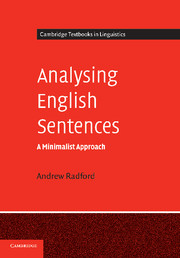Preface
Summary
Aims
This book supercedes my Minimalist Syntax book, published in 2004. Although there is much in common between the two books, it should be noted that this book contains new material and new analyses (particularly in later chapters). It has two main aims. The first is to provide an intensive introduction to recent work in syntactic theory (more particularly to how the syntactic component operates within the model of grammar assumed in recent work within the framework of Chomsky's Minimalist Program). The second is to provide a description of a range of phenomena in English syntax, making use of Minimalist concepts and assumptions wherever possible.
Key features
The book is intended to be suitable both for people with only minimal grammatical knowledge, and for those who have already done quite a bit of syntax but want to know something (more) about Minimalism. It is not historicist or comparative in orientation, and does not presuppose knowledge of earlier or alternative models of grammar. It is written in an approachable style, avoiding unnecessary complexity and unexplained jargon. Each chapter contains:
a core text (divided up into ten sections or so) focusing on a specific topic
a summary recapitulating the main points in the chapter
a list of key concepts/principles introduced in the chapter
a bibliographical section providing extensive references to original source material
a workbook section containing two different kinds of exercise
a set of model answers accompanying the exercises, together with extensive helpful hints designed to eliminate common errors students make and to help students whose native language is not English
an extensive glossary and integral list of abbreviations
- Type
- Chapter
- Information
- Analysing English SentencesA Minimalist Approach, pp. xi - xiiiPublisher: Cambridge University PressPrint publication year: 2009

